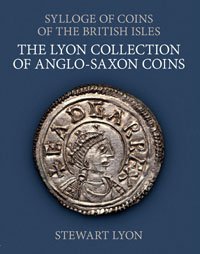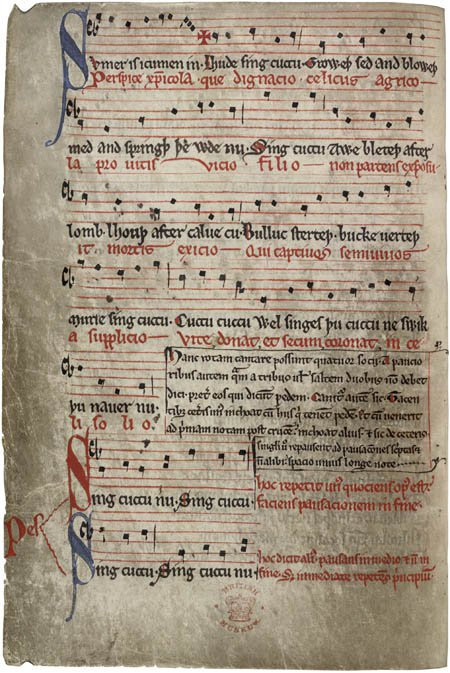Published in British Academy Review, No. 29 (January 2017).
The print version of this article can be downloaded as a PDF file.
The British Academy publishes a range of research resources, including series of edited texts and illustrated catalogues of archaeological artefacts, produced through long-running British Academy Research Projects. Recent publications have made available a range of medieval content – including several volumes in the Auctores Britannici Medii Aevi series, which publishes editions and translations of important works of medieval British thought.
Discussed further in this article are two illustrated volumes that provide evidence for very different aspects of the medieval world.
Anglo-Saxon coins – catalogued
The Sylloge of Coins of the British Isles (SCBI) series was conceived in the 1950s, at a time when it was feared that a number of major coin collections – mostly private – were about to be dispersed. There was a desire that coin collections should be recorded in a way that would make them accessible to scholars for posterity.
At that time, there was much less contact between academic historians, and numismatists, who tended to be people studying coins in their spare time, or people working in museums. In the case of Anglo-Saxon coinage, on which the SCBI series has been particularly strong, an unusually close relationship between academics and numismatists was emerging.
Dr Rory Naismith, General Editor of SCBI explains the value of the series: ‘The study of coin evidence gives you a great new window onto one dimension of the Anglo- Saxon economy. Coins were not used for everything. They were mainly silver coins, so were valuable compared to what we are used to nowadays – each Anglo-Saxon penny having the equivalent of probably several tens of pounds in buying power. You would look very hard if you dropped one.’

The 68th volume in the SCBI series is a catalogue of the collection of Anglo-Saxon coins assembled by Stewart Lyon. Dr Lyon first became interested in coins and in collecting them as a schoolboy. ‘I’m not quite sure exactly how. The story is that I found a George III half crown in a sewing box of my mother’s, but that may be more imaginary than factual.’ He put together a small collection of coins, ‘with an occasional incursion into Anglo Saxon coins’.
In the 1950s, he was encouraged by Michael Dolley, a curator at the British Museum, to do some research on the abundant copper coinage of the 9th-century Kingdom of Northumbria, a series in which he had become interested. ‘I travelled the country, examining collections of these, particularly ones in York. I very soon came to the conclusion that much of what had been written about them, mainly in the 19th century, was misguided.’ In his profession as an actuary, Lyon was used to looking for patterns, and this has been the essence of most of his numismatic work: ‘looking for patterns in data, in portraits, in inscriptions and so forth’. In the new SCBI volume, Lyon has brought up to date his research on this Northumbrian coinage and what it can tell us.
A die is a piece of metal used to impress an image on one side of a coin. When you examine two coins, you sometimes find that the dies used to strike them must have been the same: this is called a die link. Looking at die linking patterns has been a constant part of Lyon’s work. And that in turn has driven his collecting choices. He would look to acquire examples of new dies, new styles of die engraving; or coins bearing the names of different moneyers (the person accountable for the production of a coin) or different towns where the coins had been minted. ‘Essentially, if I had developed an idea about style in relation to a part of the country, it was useful to build up at least a small number of examples of the coins concerned.’
And that makes Lyon’s collection different to museum collections – particularly ones acquired through hoard finds. If you have a major hoard in a collection, that gives you an insight into a narrow period of coinage. Instead, Lyon’s collection is dominated by his exploration of the chronological and geographical classifications of particular coinages – such as the Small Cross coins of King Æthelred II (the Unready). ‘It is a very lumpy collection, essentially research-based. That’s why I think it’s valuable to publish it in the SCBI series.’
The evidence contained in this published collection provides unique insights for the historian. Even when the coins bear the king’s head, variations in coin design can reveal regional administrative autonomy – as, for example, in the case of Æthelflæd, the Lady of the Mercians (d. 918), during part of the reign of her brother, King Edward the Elder (899-924), or by Edgar in England north of the Thames during the reign of his brother King Eadwig (957-9).
Even when England was first conquered by Sweyn and then Cnut in the early 11th century (1013-16), coins continued to be issued in the name of Æthelred II. Cnut did not produce coins as king of England perhaps until his coronation. What was it that entitled a king to put his name on the coinage? Dr Lyon says: ‘I don’t think we can answer that question. But one does get the impression that at this time there had to be a very definite acceptance of a ruler before his name was put on the coinage.’
Thirteenth-century music manuscripts – illustrated
The British Academy’s Early English Church Music (EECM) series aims to make available church music by British composers from Anglo-Saxon times to the Commonwealth.
The 57th volume in the EECM series, published in November 2016, is a landmark facsimile edition containing 13th-century sources of polyphonic music. Very few manuscripts survive, and the 350-odd colour images in this volume reproduce almost the entire corpus of English music manuscripts found in Great Britain, Germany, France and the USA.
According to Professor Magnus Williamson, EECM’s General Editor, ‘perhaps the most important single concentration of sources is the Worcester Fragments, remnants of three substantial codices from the third quarter of the 13th century, and of emblematic status in the history of British music. These books were originally used at Worcester’s Benedictine cathedral priory, dismembered by 1530, and subsequently found in the bindings of books now in the British Library, the Bodleian and Worcester Cathedral Library. A facsimile edition of this type enables its editors, William Summers and Peter Lefferts, to reunite the surviving leaves of the Worcester codices for the first time since the 1520s.’
The volume dramatically shows the advantages of full colour reproduction. Scribes’ working methods and page-layout are intelligible; alternations of black and red ink, so characteristic of medieval manuscripts, can be seen in the elegant superimposition of black notes on red staves; and stains and fading can be seen in context. This has been made possible through the British Academy’s financial support, and also by the increasing affordability of colour reproduction of digital images [note 1]. A generous page size means that nearly all of the manuscripts can be printed at 100 per cent, thereby avoiding the need for images to be cropped or misleadingly re-scaled.

‘The images are rightly excellent because the musical contents are of outstanding interest,’ says Professor Williamson. ‘The 13th century witnessed a transformational flowering of polyphonic learning in Britain, as native musicians, led by the monastic houses, absorbed and customised Parisian traditions. In particular, the manuscripts included in EECM 57 show clearly the standing of English polyphony during the long reigns of Henry III and his son Edward I.’ Distinctive and memorable compositions such as the Reading rota (British Library, Harley 978 – illustrated below) and the conductus-rondellus Flos regalis (Corpus Christi College, Oxford, 489) are included in the volume, along with manuscripts from Arbroath, Bury St Edmunds, Canterbury, Coventry, Durham, Ely, Lanthony by Gloucester, Meaux Abbey (Yorkshire), Ramsey, Revesby, St Andrews, Thame, and Westminster.
The repertory is largely a diaspora of fragments – one of the reasons for its relative neglect, and also a rationale for publishing the whole corpus in a single volume. A facsimile of this type will throw vivid new light upon a repertory that, in the words of Summers and Lefferts, ‘has long languished in the shadow of the achievements of thirteenth-century France’.
This book was copied at the Benedictine Reading Abbey during the reign of Henry III (soon after 1265). Two voice-parts sing the repeating pes ‘Sing cuccu’; the red cross on the first stave shows the time-lapse before each succeeding singer enters with the canonic upper voice-part.
Notes
- The digital images for this facsimile edition have been supplied by Digital Image Archive of Medieval Music.